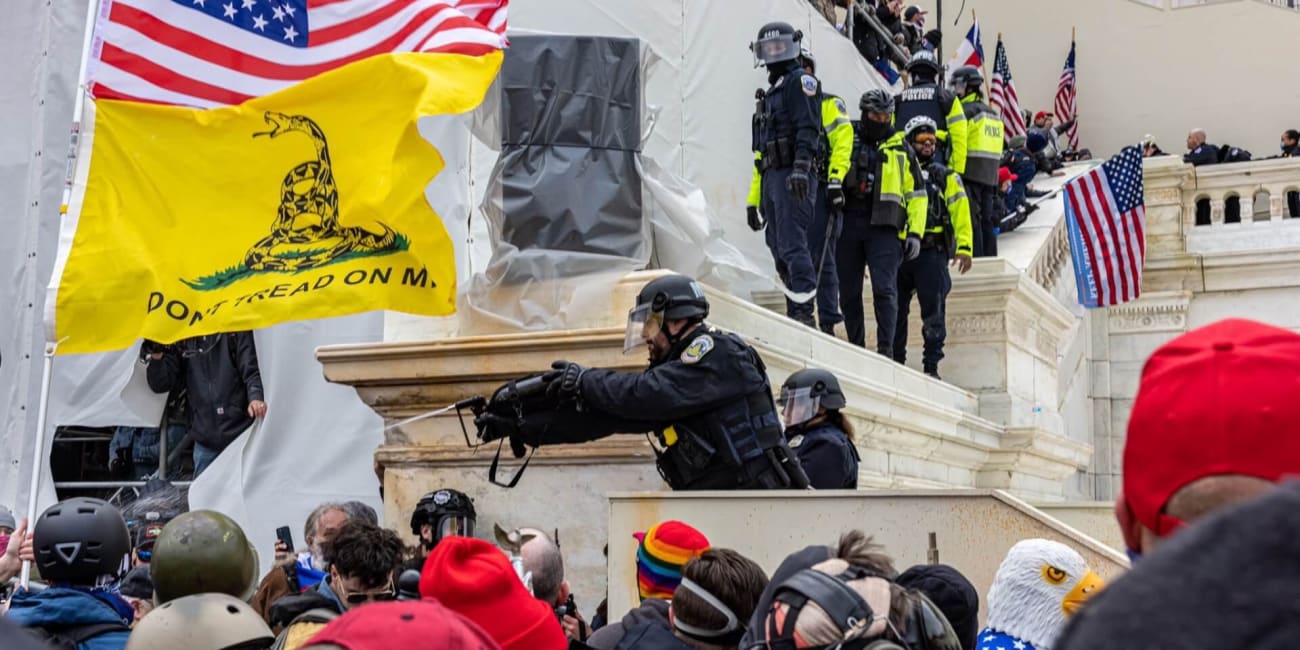|
 |
Thank you for being a free subscriber.. Don’t lose access. Please upgrade your subscription to Lincoln Square today with this limited-time offer.
Join us on the frontline in the battle for our rights and freedoms under the law. It's our duty as Americans to defend democracy. Together.
Trump Administration Cuts DHS Grants Meant to Prevent Political Violence
DHS rescinded millions in prevention grants just months before high-profile political assassinations, leaving schools and local governments struggling to maintain early-warning systems.
By Brian Daitzman
In Franklin, New Hampshire, a desk sits empty — space earmarked for an assistant principal, a role the district never hired after Washington withdrew its support.
The vacancy traces back to a single letter. Last summer, the Department of Homeland Security canceled a $486,386 prevention grant that had been covering the salaries of three counselors — jobs the district had never been able to fund on its own. When the dollars disappeared, Franklin faced a blunt equation: cut the counselors, or shoulder their salaries with local money.
The choice came with a price. The counselors stayed. The assistant principal never arrived.
These counselors were not bureaucratic extras.
They embodied a fragile experiment in prevention — federally funded staff who lived in the space between social work and public safety. They checked in on isolated students, trained teachers to spot when withdrawal was edging toward risk, and called police when a threat crossed the line from worry to danger. “We’re not going to let the federal government dictate whether we have these jobs or not,” Superintendent Dan LeGallo told a local paper, underscoring the strain of absorbing costs that Washington once covered.
The program’s logic was disarmingly simple.
A counselor might see a three-week spike in absences paired with violent online posts and trigger a team review. Vigilance was the point — catching danger in formation, before risk hardened into threat.
What remains now is more than an empty desk.
It is the trace of a federal retreat: vigilance preserved only by sacrifice, a small town maintaining its defenses at the cost of a role deliberately left unfilled.
Franklin kept its watch, but only by carrying what Washington set down.
Warnings Withdrawn
The money was modest, but the design was ambitious.
Through a little-known program at the Department of Homeland Security, grants—rarely more than half a million dollars—went to schools, counties, and nonprofits to build local capacity for preventing violence. Franklin’s share paid for three counselors the district could never have afforded on its own.
Their task straddled two worlds: providing day-to-day services to students while also training teachers to recognize early markers of danger—a child withdrawing from friends, rhetoric hardening into menace, a mental illness left untreated until it warped into despair.
In July, DHS pulled the plug. More than $15 million in awards vanished nationwide. In its press release, the department called previous grants “misdirected” and said its “essential mission” would now center on border enforcement and immigration control. In letters to grantees, DHS added a third priority: combating antisemitism (as reported from the rescission letters).
Civil-liberties advocates, including the ACLU, have long warned that prevention efforts risk blurring the line between safeguarding and surveillance if due-process protections are not explicit. Those critiques carried weight.
But Franklin showed the other side of the ledger: what happens when prevention is stripped away.
The consequences were immediate.
Programs closed overnight.
Threat-assessment teams barely launched were dissolved. Counselors who had been the first point of contact for at-risk students disappeared.
And then, within weeks, the nation saw two high-profile political killings:
Minnesota legislator Melissa Hortman and conservative activist Charlie Kirk were both assassinated.
The cuts did not cause the killings, but the symbolism was stark: prevention dismantled at the very moment the need for vigilance became undeniable.
Defunding Prevention
For nearly a decade, prevention grants gave schools and counties something they had never had before: a structured way to spot danger before it turned violent.
Born in the wake of repeated mass shootings and the rise of domestic extremism, the grants underwrote a quiet infrastructure.
They paid for counselors who doubled as early-warning specialists, watching for students in crisis.
They funded truancy officers tracking chronic absenteeism and disengagement. They supported trainings that taught teachers and police how to recognize the subtle markers of violent intent — the details that can pass unnoticed until it is too late.
In July, that scaffolding collapsed. The Department of Homeland Security rescinded more than $15 million in awards across the country — a sum less than the cost of a single fighter jet, or a week of ICE detention contracts, yet enough to dismantle a decade of fragile local prevention capacity.
Franklin received a terse letter: its $486,386 was gone. To preserve its three counselors, administrators cut elsewhere, leaving an assistant principal’s office deliberately unfilled.
The losses cascaded. In New York, more than $400,000 earmarked for threat-assessment teams created after the 2022 Buffalo supermarket massacre — where a white nationalist targeted Black shoppers — disappeared. In Pierce County, Washington, nearly all of a $706,000 grant evaporated before the county could even hire staff. “Right now, we just do not have the resources to do this independent of grant funding,” said Arel Solie, the county’s emergency management director.
The burden fell unevenly. Because most U.S. districts fund schools through local property taxes, rural and low-wealth communities were least able to absorb the loss. The rescissions hit hardest in the places least equipped to replace federal support.
The pattern was unmistakable.
From small towns to large cities, the result was the same: what had been framed as part of America’s national security architecture was dismantled overnight, leaving local governments with fewer defenses just as the risks were multiplying.
What collapsed in budgets was completed in policy: even as local capacity thinned, Washington’s gaze turned elsewhere.
Shifted Priorities
The Department of Homeland Security insists it has not abandoned its core mission. But its focus has shifted.
In recent statements, the department has stressed border enforcement and immigration control. Inside the agency, congressional inquiries show that analysts once assigned to domestic extremism have been reassigned to immigration cases — a shift critics described as gutting the office.
A lens that once scanned multiple threats now fixes on a single target. That narrowing has consequences.
This kind of pivot is not new in American security.
After the Cold War, budgets were consumed by counter-communism. After September 11, jihadist plots eclipsed nearly every other concern. In the 2010s, cyberattacks took center stage.
Each turn carried costs, but most broadened capacity: the system adapted to new dangers while still watching the old ones.
Today’s turn is different. Immigration enforcement is crowding out attention to domestic political violence, even as targeted attacks on public figures grow more frequent. The aperture does not widen; it contracts.
Symbolism has amplified the shift. In September, President Trump signed an executive order designating Antifa a domestic terrorist organization. Legal experts across the spectrum noted the order carried little effect: Antifa is not a formal group that can be banned. Analysts called it spectacle.
The order generated headlines; the counselor layoffs did not. Spectacle was rewarded, substance ignored.
And for communities that had just lost their prevention counselors, the contrast was jarring: Washington dismantled programs that worked, while elevating gestures that changed nothing about their safety.
We Are Vulnerable
The cancellation of prevention grants was not bookkeeping.
It was a redefinition of what the federal government counts as security. These programs had been created after school shootings and extremist attacks to give communities a way to act before violence.
They funded counselors trained to spot radicalization and alienation.
They supported officers who could connect struggling families with services. They sustained local teams able to judge whether troubling behavior was escalating into genuine threat.
Together, they formed an architecture of prevention — fragile, but vital.
In Franklin, administrators preserved three prevention counselors only by leaving an assistant principal’s office deliberately empty. In New York and Washington State, prevention teams dissolved outright when their dollars vanished.
A network that once stretched across the country contracted into fragments. The rescission saved Washington less than the cost of a single fighter jet, and a fraction of one percent of DHS’s $100-billion budget, yet it dismantled ten years of painstaking local capacity.
Other democracies, confronted by political violence, made the opposite choice. Germany expanded prevention after the National Socialist Underground — a neo-Nazi terror cell that murdered ten immigrants in the 2000s while police misattributed the killings to “ethnic gang” disputes.
The scandal was not only the crimes but the blindness of institutions that failed to see far-right violence for what it was. Britain strengthened its Prevent strategy, the official program under its counterterrorism framework, CONTEST. Prevent trains teachers, doctors, and local officials to recognize early signs of radicalization and, since 2015, has imposed a legal “Prevent duty” requiring public institutions to act when risks appear. Contested and criticized, Prevent nonetheless endured as civic infrastructure. Where others widened their defenses in response to bloodshed, the United States narrowed its own.
The retreat comes just as attacks are multiplying — from the white-supremacist massacre in Buffalo targeting Black residents, to assassinations of elected officials, to killings in LGBTQ clubs and immigrant neighborhoods.
Washington withdrew precisely as the danger sharpened.
The lesson is unavoidable.
Prevention is not perfect, but it buys communities time — a chance to see danger while it is still visible. By withdrawing support, the federal government turned absence into policy.
What does it say about a democracy when the only spaces it leaves dark are the ones meant to keep its children, its neighbors, and its leaders safe?
The empty desk in Franklin is not an anomaly.
It is the nation’s mirror: rooms left unfilled. Programs dissolved. Vigilance traded for neglect. And if those spaces remain dark, the danger will not wait for permission. It will arrive unseen.
Brian Daitzman is the Editor of The Intellectualist. Read the original article here.
References
Department of Homeland Security, “DHS Axes Wasteful, Misdirected Grants, Saves Taxpayers $18.5M,” July 17, 2025 — https://www.dhs.gov/news/2025/07/17/dhs-axes-wasteful-misdirected-grants-saves-taxpayers-185m
Talking Points Memo, “DHS Had a Program to Stop Political Violence. Trump Largely Abandoned It,” Sept. 30, 2025 — https://talkingpointsmemo.com/news/dhs-had-a-program-to-stop-political-violence-trump-largely-abandoned-it
DHS, “Center for Prevention Programs and Partnerships (CP3),” 2025 — https://www.dhs.gov/keywords/center-prevention-programs-and-partnerships-cp3
Concord Monitor, “Franklin Schools Lose Nearly $500K Federal Prevention Grant,” July 22, 2025 — https://www.concordmonitor.com/franklin-schools-lose-prevention-grant-2025
Associated Press via MPR, “Conservative Activist Charlie Kirk Assassinated at Utah University,” Sept. 10, 2025 — https://www.mprnews.org/story/2025/09/10/charlie-kirk-shot-utah
PBS/AP, “Live Updates: Turning Point USA Co-Founder Charlie Kirk Fatally Shot at Utah College Event,” Sept. 10, 2025 — https://www.pbs.org/newshour/politics/live-updates-turning-point-usa-co-founder-charlie-kirk-shot-at-utah-college-event
Associated Press, “Minnesota House to Return to Full Strength After Lawmaker’s Assassination,” Aug. 22, 2025 — https://apnews.com/article/282a82fd64264c68515b577e5dc04c9b
The Guardian, “Minnesota House Speaker Melissa Hortman assassinated at home in targeted political attack,” Sept. 1, 2025 — https://www.theguardian.com/us-news/2025/sep/01/minnesota-house-speaker-melissa-hortman-killed
Senate Judiciary Committee, “Letter on Reassignment of Domestic Extremism Staff,” Apr. 8, 2025 — https://www.judiciary.senate.gov/letters/040825-dhs-fbi-domestic-extremism-staff-reassignments
White House, “Executive Order on Designating Antifa as a Domestic Terrorist Organization,” Sept. 22, 2025 — https://www.whitehouse.gov/presidential-actions/executive-order-designating-antifa-domestic-terrorist-organization
CBS News, “Trump Signs Order Designating Antifa a Terrorist Group,” Sept. 23, 2025 — https://www.cbsnews.com/news/trump-antifa-executive-order-domestic-terrorist-organization
The Guardian, “Minnesota House Speaker Melissa Hortman assassinated at home in targeted political attack,” Sept. 1, 2025 — https://www.theguardian.com/us-news/2025/sep/01/minnesota-house-speaker-melissa-hortman-killed
You’re currently a free subscriber to Lincoln Square Media. For full access to our content, our Lincoln Loyal community, and to help us amplify the facts about the assault on our rights and freedoms, please consider upgrading your subscription today with this limited-time offer:
Not ready to subscribe? Make a one-time donation of $10 or more to support our work amplifying the facts on social media, targeted to voters in red states and districts that we can help flip. Every $10 reaches 1000 Americans. The Truth needs a voice. Your donation will help us amplify it.
Want to help amplify this post? Please leave a comment and tell us what you think.

